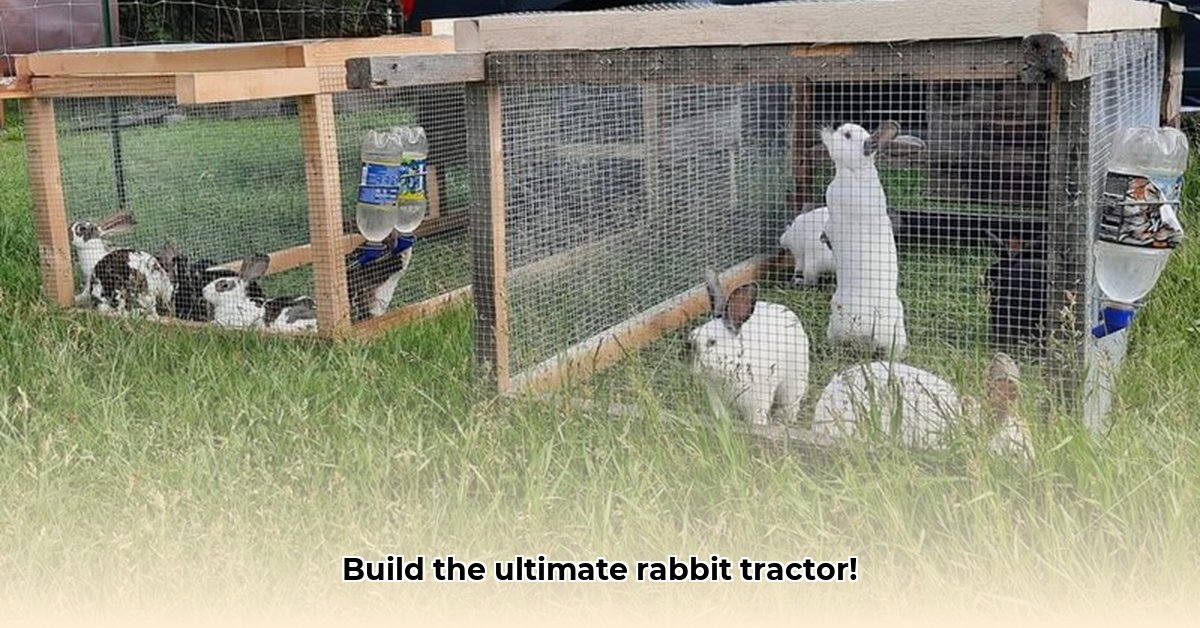
Building a rabbit tractor offers a superior alternative to traditional hutches, providing your rabbits with fresh grazing while ensuring their safety. This comprehensive guide will walk you through the process, from initial planning to ongoing maintenance, empowering you to create a thriving haven for your furry friends. For similar projects, check out this chicken tractor guide.
Planning Your Rabbit Tractor: Design for Success
Before construction begins, careful planning is crucial. Consider these key factors:
Size: How many rabbits will occupy the tractor? Experts recommend a minimum of 10-15 square feet per rabbit, ensuring ample space for comfortable movement and grazing. Larger is always better! Do you anticipate expanding your rabbitry in the future? Design with potential growth in mind.
Materials: The choice of materials significantly impacts the tractor's durability, weather resistance, and predator protection. Common options include:
- Wood: Offers excellent insulation, but requires regular maintenance (weatherproofing, painting). Pressure-treated lumber is durable but check labels to ensure rabbit safety.
- Wire Mesh: Provides good ventilation, but offers less protection from the elements and may require extra reinforcement against determined bunnies. Hardware cloth (fine mesh) is vital for predator protection.
Combine wood and wire mesh for optimal results. A sturdy wood frame provides structure, while wire mesh ensures ventilation and predator protection.
Climate Considerations: Your region's climate dictates essential design adaptations.
- Hot Climates: Prioritize shade and ventilation. Incorporate a tarp for additional shade or design partially enclosed areas for cool respite.
- Cold Climates: Focus on insulation. A covered area within the tractor, a tarp, or additional bedding will help your rabbits stay warm.
Predator Protection: This is paramount. Use sturdy hardware cloth (small mesh size) to prevent access by predators such as foxes, raccoons, and weasels. Ensure the bottom edge is securely buried to deter digging. Regular inspections are crucial.
Ease of Cleaning: Design for easy cleaning. Removable panels or a slightly sloped floor will simplify maintenance and reduce the risk of disease.
Step-by-Step Construction Guide: Building Your Bunny's Paradise
Follow these steps to construct your rabbit tractor:
Cut the Materials: Accurately measure and cut the wood and wire mesh according to your design. Precise cuts will ensure a smooth assembly process. Remember safety first - always use appropriate safety gear.
Assemble the Frame: Construct the frame using screws or bolts for a strong, stable structure. Reinforce corners to withstand energetic bunny behavior!
Attach the Wire Mesh: Securely attach the wire mesh or hardware cloth to the frame, ensuring a completely sealed enclosure preventing escapes and predator intrusion. Overlap panels and secure with strong wire ties or clamps.
Install a Door: Cut and install a secure door for easy access to food, water, and cleaning. Choose hinges and a latch suitable for the size and weight of the door.
Add Wheels (Optional): Attach heavy-duty casters for mobility, allowing you to easily rotate grazing areas and prevent pasture overgrazing.
Construct the Roof: Build a removable roof to protect your rabbits from the elements. Consider materials that are easy to clean and maintain.
Final Touches: A simple ramp can facilitate entry and exit. Consider painting or sealing the wood for weather protection and longevity.
Post-Construction Care: Ensuring a Healthy Habitat
Maintaining your rabbit tractor is vital for your bunnies' well-being.
- Cleaning: Daily spot cleaning and weekly deep cleaning are essential to prevent the buildup of harmful bacteria and parasites. Use appropriate disinfectants.
- Pasture Rotation: Regularly move the tractor to new areas, preventing overgrazing and minimizing parasite build-up.
- Predator Monitoring: Regularly inspect the tractor for any signs of damage or predator activity. Address any vulnerabilities immediately.
Troubleshooting and FAQs
Problem: Rabbits are escaping. Solution: Carefully inspect the wire mesh for gaps or weaknesses. Repair any holes and reinforce weak sections.
Problem: The tractor is too hot or cold. Solution: Adjust shading or insulation as needed. Consider relocating the tractor.
Problem: Parasite infestation. Solution: Consult your veterinarian for appropriate parasite control measures and implement a preventative program, including regular pasture rotation.
Conclusion: Empowering Your Homestead
Building a DIY rabbit tractor is a rewarding experience that enhances your homestead and improves the quality of life for your rabbits. By following these guidelines and prioritizing your bunnies’ well-being, you can create a safe, comfortable, and enriching environment for them. Remember, a little planning and effort go a long way!